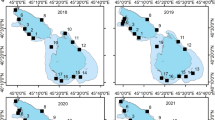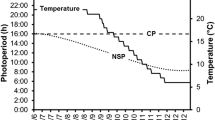Abstract
This paper describes and evaluates the mortality associated with the potential stressor effect induced by application of artificial photoperiods in rainbow trout (Oncorhynchus mykiss). After application of artificial photoperiods, high mortalities of trout subjected to this management were recorded (36% in LD 14:10 and 25% in LD 24:0) as compared to controls (7%). The recorded signology related to diseased trout included darkening, lethargy and erratic swimming. Among the morphological changes, skin lesions and ulcerative-type necrosis could be observed. Blood tests, histopathology and isolation of pathogens identified as Flavobacterium psychrophilum, associated with Aeromonas, Pseudomonas and Saprolegnia sp., were performed. The application of artificial photoperiods suggests that fish may be more susceptible to opportunistic diseases; thus, it is advisable to emphasize preventive measures in fish subjected to this management.



Similar content being viewed by others
References
Almazan-Rueda P, Schrama JW, Verreth JAJ (2004) Behavioural responses under different feeding methods and light regimes of the African catfish (Clarias gariepinus) juveniles. Aquaculture 231:347–359
Anaker RL, Ordal EJ (1959) Studies on the myxobacterium Chondrococcus columnaris. 1. Serological typing. J Bacteriol 78:25–32
Arendt J, Aldhous M, Wright J (1988) Synchronization of a disturbed sleep-wake cycle in a blind man by melatonin treatment. Lancet i:772–773
Austin B, Austin DA (1993) Bacterial fish pathogens: disease in farmed and wild fish, 2nd edn. Chichester, Ellis Horwood (Aquaculture and Fisheries Support Series), 384 p
Bernardet J-F, Kerouault B (1989) Phenotypic and genomic study of Cytophaga psychrophila isolated from diseased rainbow trout (Oncorhynchus mykiss) in France. Appl Environ Microbiol 55:1796–1800
Biswas AK, Morita T, Yoshizaki G, Maita M, Takeuchi T (2005) Control of reproduction in Nile tilapia Oreochromis niloticus (L.) by photoperiod manipulation. Aquaculture 243:229–239
Biswas AK, Seoka M, Takii K, Maita M, Kumai H (2006a) Stress response of red sea bream Pagrus major to acute handling and chronic photoperiod manipulation. Aquaculture 252:566–572
Biswas AK, Seoka M, Tanaka Y, Takii K, Kumai H (2006b) Effect of photoperiod manipulation on the growth performance and stress response of juvenile red sea bream (Pagrus major). Aquaculture 258:350–356
Biswas AK, Seoka M, Ueno K, Yong ASK, Biswas BK, Kim YS, Takii K, Kumai H (2008) Growth performance and physiological responses in striped knifejaw, Oplegnathus fasciatus, held under different photoperiods. Aquaculture 279:42–46
Bondad-Reantaso MG, Subasinghe RP, Arthur JR, Ogawa K, Chinabut S, Adlard R, Tan Z, Shariff M (2005) Disease and health management in Asian aquaculture. Vet Parasitol 132:249–272
Bromage N, Porter M, Randall C (2001) The environmental regulation of maturation in farmed finfish with special reference to the role of photoperiod and melatonin. Aquaculture 197:63–98
Burridge L, Weis JS, Cabello F, Pizarro J, Bostick K (2010) Chemical use in salmon aquaculture: a review of current practices and possible environmental effects. Aquaculture 306:7–23
Cipriano RC, Holt RA (2005) Flavobacterium psychrophilium, cause of bacterial cold-water disease and rainbow trout fry-syndrome. Fish disease leaflet No. 86. USDI, USGS, National Fish Health Research Laboratory, Kearneyville, W.V.
Cipriano RC, Schill WB, Teska JD, Ford LA (1996) Epizootiological study of bacterial cold-water disease in Pacific salmon and further characterization of the etiologic agent, Flexibacter psychrophila. J Aquatic Animal Health 8:28–36
Duray M, Kohno H (1988) Effects of continuous lighting on growth and survival of first-feeding larval rabbitfish Siganus guttatus. Aquaculture 72:73–79
Fielder DS, Bardsley WJ, Allan GL, Pankhurst PM (2002) Effect of photoperiod on growth and survival of snapper Pagrus auratus larvae. Aquaculture 211:135–150
Han T, Wu C, Tong Z, Mentreddy RS, Tan K, Ga J (2006) Postflowering photoperiod regulates vegetative growth and reproductive development of soybean. Environ Exp Bot 55:120–129
Hansen T, Karlsen O, Taranger GL, Hemre G-I, Holm JG, Kjesbu OS (2000) Growth, gonadal development and spawning time of Atlantic cod (Gadhus morhua) reared under different photoperiods. Aquaculture 203:51–67
Kent ML, Feist SW, Harper C, Hoogstraten-Miller S, Mac Law J, Sánchez-Morgado JM, Tanguay RL, Sanders GE, Spitsbergen JM, Whipps CM (2009) Recommendations for control of pathogens and infectious diseases in fish research facilities. Comp Biochem Physiol C Toxicol Pharmacol 149:240–248
Leiner KA, Mackenzie DS (2001) The effects of photoperiod on growth rate and circulating thyroid hormone levels in the red drum, Sciaenops ocellatus: evidence for a free-running circadian rhythm of T4 secretion. Comp Biochem Physiol 130:141–149
Leonardi M, Klempau A (2003) Artificial photoperiod influence on the immune system of juvenile rainbow trout Oncorhynchus mykiss. Aquaculture 221:581–591
MacPherson AJ, Geuking MB, McCoy KD (2005) Immune responses that adapt the intestinal mucosa to commensal intestinal bacteria. Immunology 115:153–162
Melingen GO, Pettersen EF, Wergeland HI (2002) Leukocyte populations and responses to immunization and photoperiod manipulation in Atlantic salmon (Salmo salar L.) 0 + smolt. Aquaculture 214:381–396
Migaud H, Fontaine P, Sulistyo I, Kestemont P, Gardeur JN (2002) Induction of out-of-season spawning in Eurasian perch Perca fluviatilis: Effects of cooling and chilling periods on female gametogenesis and spawning. Aquaculture 205:253–267
Migaud H, Mandiki R, Gardeur JN, Kestemont P, Bromage N, Fontaine P (2003) Influence of photoperiod regimes on the Eurasian perch gonadogenesis and spawning. Fish Physiol Biochem 28:395–397
Morenike AA, Comfort AA, Ademola BA (2008) Feed utilization, growth and survival of Clarias gariepinus (Burchell, 1822) fingerlings cultured under different photoperiods. Aquaculture 283:64–67
Moustakas CT, Watanabe WO, Copeland KA (2004) Combined effects of photoperiod and salinity on growth, survival, and osmoregulatory ability of larval southern flounder Paralichthys lethostigma. Aquaculture 229:159–179
Murray AG, Peeler EJ (2005) A framework for understanding the potential for emerging diseases in aquaculture. Prev Vet Med 67:223–235
Puvanendran V, Brown JA (1998) Effect of light intensity on the foraging and growth of Atlantic cod larvae: interpopulation difference? Mar Ecol Prog Ser 167:207–214
Puvanendran V, Brown JA (1999) Foraging, growth and survival of Atlantic cod larvae reared in different prey concentrations. Aquaculture 175:77–92
Puvanendran V, Brown JA (2002) Foraging, growth and survival of Atlantic cod, Gadus morhua, larvae reared in different light intensities and photoperiods. Aquaculture 214:131–151
Skarmeta AM (1996) Caracterización bioquímica, serológica y molecular del patógeno de peces Flexibacter psychrophilus. Doctoral Thesis, Universidad de Santiago de Compostela, Spain
Taylor JF, North BP, Porter MJR, Bromage NR, Migaud H (2006) Photoperiod can be used to enhance growth and improve feeding efficiency in farmed rainbow trout, Oncorhynchus mykiss. Aquaculture 256:216–234
Valenzuela AE, Silva VM, Klempau AE (2006) Effects of constant light on haematological parameters of cultured rainbow trout (Oncorhynchus mykiss) in the Southern Hemisphere. Fish Physiol Biochem 32:113–120
Van der Salm AL, Nolan DT, Wendelaar Bonga SE (2002) In vitro evidence that cortisol directly modulates stress-related responses in the skin epidermis of the rainbow trout (Oncorhynchus mykiss Walbaum). Fish Physiol Biochem 27:9–18
Wang N, Migaud H, Acerete L, Gardeur JN, Tort L, Fontaine P (2003) Mortality and non-specific immune response of Eurasian perch, Perca fluviatilis, during the spawning season. Fish Physiol Biochem 28:523–524
Wu L, Wang T, Ku L, Huang Q, Sun Z, Xia Z, Chen Y (2008) Determination of the photoperiod-sensitive inductive phase in maize with leaf numbers and morphologies of stem apical meristems. Agric Sci China 7:554–560
Acknowledgments
The authors acknowledge the help offered by Mr. Ricardo Quiroz, manager of the PANGUE Fish Farm. This research was funded by the FONDECYT Project # 11090246.
Author information
Authors and Affiliations
Corresponding author
Rights and permissions
About this article
Cite this article
Valenzuela, A., Campos, V., Yañez, F. et al. Application of artificial photoperiod in fish: a factor that increases susceptibility to infectious diseases?. Fish Physiol Biochem 38, 943–950 (2012). https://doi.org/10.1007/s10695-011-9580-2
Received:
Accepted:
Published:
Issue Date:
DOI: https://doi.org/10.1007/s10695-011-9580-2




